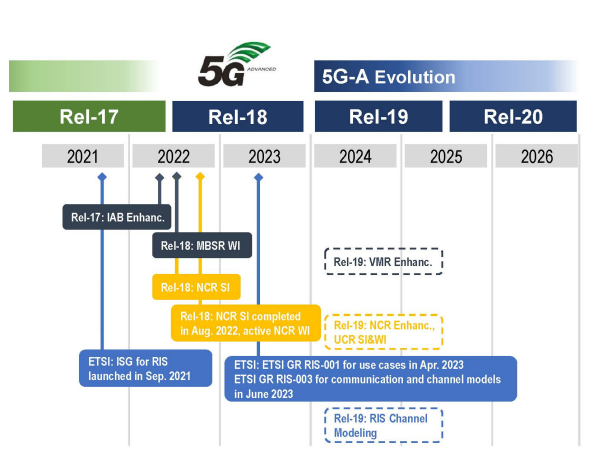5G NCR – Network Controlled Repeaters
5G NCR – Network Controlled Repeaters
To improve the network coverage, non-regenerative RF repeaters are simpler solution. A RF repeaters, works on the principal of amplify-and-forward the signal. RF repeaters have been widely deployed in commercial 2G, 3G, and 4G networks. As 5G NR technology evolving to higher frequencies, signal propagation conditions may deteriorate, necessitating the critical implementation of RF repeaters.
3GPP RAN4 introduced specifications for RF repeaters to meet this increasing demand within Release 17. These specifications lay out requirements for FR1 and FR2 in terms of RF and Electromagnetic Compatibility to ensure compatibility in typical commercial environments.
We know RF repeaters are cost-effective for expanding network coverage, but they are limited in terms of accommodating factors that enhance network performance and efficiency, like dynamic DL/UL configurations, adaptive spatial beamforming, and ON-OFF stages. To overcome these limitations, 3GPP initiated a new Study Item in May 2022 focusing on Network Controlled Repeaters (NCRs).
NCRs carry forward the legacy amplify and forward operation of RF repeaters, but also receive control information from the 5G gNB to function more efficiently. Using this control information, NCRs enable transmissions and receptions with improved spatial directivity, enable easy network integration, and minimize unwanted interference.
NCR Roadmap
The Study Item for NCRs was finalized in August 2022, and 3GPP is currently developing the NCR Work Items. Figure 1 provides an overview of 3GPP’s NCR roadmap.

NCR Technical Scope
The scope of NR NCRs provided in the NCR 3GPP Work Item is defined more narrowly when compared to IAB. NCRs primarily focus on the following scenarios and assumptions:
- NCRs are in-band RF repeaters used to extend network coverage on FR1 and FR2 bands, as per the NCR model in TR38.867
- Only single-hop stationary NCRs are considered
- The NCR is transparent to the UE
- The NCR can maintain the gNB-repeater link and the repeater-UE link simultaneously
Following Table provides a summary of the comparisons between IAB and NCR.

Network Controlled Repeaters – NCR Architecture
The Architecture is shown in following figure and it is consists of two following main functional blocks:
- NCR-Mobile Termination (NCR-MT)
- NCR-Forwarding (NCR-Fwd)
NCR-MT block establishes communication with gNB through a Control link (C-link) using the NR Uu interface. It enables to exchange of side control information, such as beamforming, UL/DL switching, and ON/OFF turning, to manage the NCR-Fwd block.
The NCR-MT provides the exchange of control and status signaling with the gNB through the C-link. It is designed to support a subset of UE functions to fulfill its role. Regarding the transmission and reception of the C-link and backhaul link by the NCR, the following points apply:
- The DL of the C-link and DL of the backhaul link can be performed simultaneously or in a TDM manner.
- The UL of the C-link and UL of the backhaul link can be performed in a TDM manner.
The gNB controls the multiplexing while considering the capabilities of the NCR. The simultaneous transmission of the UL of the C-link and UL of the backhaul link depends on the NCR’s capability.

NCR-Fwd block amplifies and forwards UL/DL RF signals between the gNB and the UE through the backhaul and access links. The NCR-Fwd block is implemented with two sets of panel antennas i.e. one for the backhaul link and the other for the access link and one RF amplifier as shown in above figure.
The NCR-Fwd blcok primarily focuses on signal amplification and (analog) beamforming, eliminating the need for advanced digital receiver or transmitter chains. The performance requirements for beamforming antennas in the NCR-Fwd are not as high as those for macro BS or IAB node antennas. Cost-effectiveness and ease of manufacturing are prioritized.
Both NCR-MT and NCR-Fwd can operate in the same or different frequency bands. However, at least one carrier used by the NCR-MT must operate within the frequency band being forwarded by the NCR-Fwd, which serves as the baseline. When the NCR-MT and NCR-Fwd operate in the same frequency band, the C-link and backhaul link will encounter similar large-scale channel properties, simplifying the control of the backhaul link between the gNB and the NCR-Fwd.
Related Post
References
- 3GPP TR 38.867 Study on NR network-controlled repeaters
- RP-202813 New WID proposal for NR repeaters,
- RP-222673 New WID on NR network-controlled repeaters
